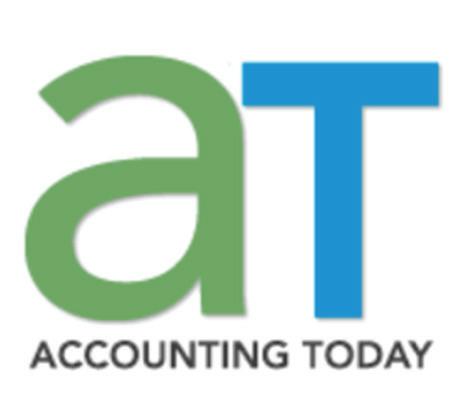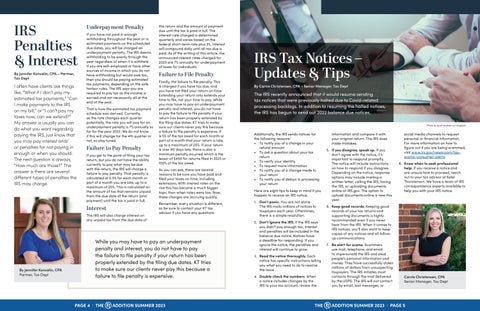ADDITION THE
Volume 29 Issue 2
CONTENTS
Performance = DOA
PAGE 1 - 2
Ag Producers – The Value of Making Your Required Annual Tax Payment by January 15th
PAGE 2 - 3
IRS Penalties & Interest
PAGE 4
IRS Tax Notices – Updates & Tips
PAGE 5
SD State Sales Tax: New Rate
Effective July 1, 2023
PAGE 6
Building Up the Section 45L Energy Credit
PAGE 7
Making Translucency Out of Transparency: Our Take on the Corporate Transparency Act
PAGE 8 - 9
Promotions, New Hires, Interns & Happenings
PAGE 10 – 11
Performance = DOA
By Steph McCoy, SHRM – Manager, Human Resources Dept
Addressing employees who are not meeting your performance standards is a challenging feat. And unfortunately, no one has come up with a pill, magic wand, or corrective recourse. That means to be successful, you must learn how to effectively address performance issues.

Below I have outlined the don’ts and the do’s when addressing performance problems in the workplace.
DON’TS - Things I would NOT recommend:
RAPID CITY, SD 810 Quincy Street (605) 342-5630
SPEARFISH, SD 741 Main Street, Ste. 230 (605) 642-7676
GILLETTE, WY 305 S. Garner Lake Road (307) 685-4433
• Be passive aggressive.
• Talk about the issue with everyone but the employee.
• Wait to address the issue until it is time for promotion or compensation increase.
• Rate them as average until they are moved to a new supervisor.
• Create an environment that motivates them to quit.
• Respond or react emotionally.
• Make an employment decision before you have all the facts.
DO’S - Things I recommend:
• Diagnose the problem. The best advice I received is to use the equation Performance = DOA .
• D - Does the employee have the desire to do the job?
• O - Have they had the opportunity to meet your expectations?
• A - Do they have the ability?
• The answers to these three questions need to align to equal performance.
• Once you diagnose the root of the issue, then you can decide how to respond.
• Be prompt in addressing the issue. Why give it time to get worse? A lag in response can also lead to headaches if you decide to take employment action in the future.
CONTINUED ON PAGE 2
THE ADDITION SUMMER 2023 • PAGE 1
SUMMER 2023
Photo by Ludde Lorentz on Unsplash
A Publication of Ketel Thorstenson, LLP
PERFORMANCE=DOA FROM PAGE 1
• Create a conversation checklist. Go into the meeting to discuss the issue with a plan. Be direct but human and assume most employees do not intentionally want to perform poorly.
✓ I want to speak with you about this specific issue.
✓ Here is what I observed.
✓ Here is what I expect. (Have the policy or procedure to reference if there is one.)
✓ What is causing the expectation to not be met? Ask and then listen, this is where you diagnose.
✓ This is how we work to correct the issue.
✓ Set a timeline for improvement and define the improvement metrics.
✓ Here is what will occur if there is no improvement.
✓ This is how we will communicate as we work towards a successful resolution.
• Document. If it is not in writing, it did not happen. Documenting the conversation, issue, and action items ensures the employee is receiving the message correctly. It can be easy to not hear or hear something different during a conversation. Documentation also is your foundation for any future employment action and the communication tool for their next supervisor or others to reference performance history.
• Act if no improvement. Follow your progressive disciplinary policies to take the next steps. Sometimes the employee is just not right for the job. Do not let that affect the rest of your employees or the success of your business.
In short, be ready to diagnose, prepare, listen, document, and act, and do so with empathy. By following these recommendations, you will see improvements in your employee performance review process.
Ag Producers
Steph McCoy, SHRM Manager, HR Dept

AG PRODUCERS FROM PAGE 2
This along with spring calving and other seasonal work on the ranch can make meeting this deadline extremely challenging.
One option available to avoid this deadline is to make use of the January 15th estimate. A qualifying farmer can file an estimated tax payment by January 15th that is the lessor of either two-thirds of the current year or 100% of last year’s tax. By making this tax payment before January 15th, you gain additional time to gather the needed information to prepare your tax return.

The amount of this estimated annual tax payment can be calculated using the worksheet that goes with the form 1040-ES. The following rules apply:
• On line 12a, multiply line 11c by 66 2/3% (0.6667).
• On line 12b, enter 100% of the tax shown on your prior year tax return regardless of the amount of your adjusted gross income.
• On line 12c, find the smaller of the two amounts and this is the amount of the required payment needed to avoid any penalty or interest.
Please contact your Ketel Thorstenson Ag Tax Professional if you are unsure if you qualify or need help calculating the estimated tax payment. More information can also be found in IRS Publication 225 - Farmer’s Tax Guide, and IRS Publication 505 - Tax Withholding and Estimated Tax
Brian Watland, MBA Manager, Tax Dept

The Value of Making Your Required Annual Tax Payment by January
15th
By Brian Watland, MBA – Manager, Tax Dept
One of the special tax provisions that applies to qualified farmers is relief from the estimated tax requirements. Agriculture Producers may be familiar
with the IRS rule stating that qualifying farmers who make two-thirds of their gross income from farming can wait to make their annual income tax payment until they file their tax return if the tax return and payment are made before March 1.
The “March 1 Farm Deadline” puts tremendous pressure both on the qualifying producer as well as their tax professionals. There are many challenges to meeting this deadline, and those have only increased over the past few years. These challenges include late arriving source tax information, including brokerage statements from investment accounts or K1’s from businesses investments, late changing tax laws, tax forms not being released in time, and the everincreasing complexity of tax returns.
CONTINUED ON PAGE 3
PAGE 2 • THE ADDITION SUMMER 2023 THE ADDITION SUMMER 2023 • PAGE 3
–
IRS Penalties & Interest
By Jennifer Konvalin, CPA – Partner, Tax Dept
I often have clients ask things like, “What if I don’t pay my estimated tax payments,” “Can I make payments to the IRS on my bill,” or “I can’t pay my taxes now, can we extend?”
My answer is usually you can do what you want regarding paying the IRS, just know that you may pay interest and/ or penalties for not paying in enough or when you should. The next question is always, “How much are those?” The answer is there are several different types of penalties the IRS may charge.
Underpayment Penalty
If you have not paid in enough withholding throughout the year or in estimated payments on the scheduled due dates, you will be charged an underpayment penalty. The IRS deems withholding to be evenly through the year regardless of when it is withheld. If you are self-employed or have other sources of income in which you do not have withholding but would owe tax, then you should be paying estimated tax payments, depending on the safe harbor rules. The IRS says you are required to pay tax as the income is earned and not necessarily all at the end of the year.
That is how the estimated tax payment schedule was derived. Currently, as the rate changes each quarter potentially, the rate you will pay for an underpayment penalty is 7% annually so far for the year 2023. We do not know if this will change for the 4th quarter or not, so stay tuned.
Failure to Pay Penalty
If you get to the point of filing your tax return, but you do not have the ability currently to pay what may be due with the return, the IRS will charge a failure to pay penalty. That penalty is calculated at 0.5% for each month or part of a month you are late, up to a maximum of 25%. This is calculated on the amount of tax that remains unpaid from the due date of the return (and payment) until the tax is paid in full.
Interest
The IRS will also charge interest on any unpaid tax from the due date of
the return and the amount of payment due until the tax is paid in full. The interest rate charged is determined quarterly and varies based on the federal short-term rate plus 3%. Interest will compound daily until all tax due is paid. As of the writing of this article, the announced interest rates charged for 2023 are 7% annually for underpayment of taxes for individuals.
Failure to File Penalty
Finally, the failure to file penalty. This is charged if you have tax due, and you have not filed your return on time. Extending your return only extends your time to file, not your time to pay. While you may have to pay an underpayment penalty and interest, you do not have to pay the failure to file penalty if your return has been properly extended by the filing due dates. KT tries to make sure our clients never pay this because a failure to file penalty is expensive. It is 5% of the tax owed for each month or part of a month that your return is late, up to a maximum of 25%. If your return is over 60 days late, there is also a minimum penalty incurred which is the lessor of $450 for returns filed in 2023 or 100% of the tax owed.
As you can see, there are several reasons to be sure you have paid and filed your taxes on time, including extensions. With interest rates on the rise this has become a much bigger topic than when rates were low. Now, these charges are accruing quickly. Remember, every situation is different, so be sure to contact your KT tax advisor if you have any questions.
IRS Tax Notices –Updates & Tips
By Carrie Christensen, CPA – Senior Manager, Tax Dept


The IRS recently announced that it would resume sending tax notices that were previously halted due to Covid-related processing backlogs. In addition to resuming the halted notices, the IRS has begun to send out 2022 balance due notices.

Additionally, the IRS sends notices for the following reasons:
• To notify you of a change in your refund amount
• To ask a question about your tax return
• To verify your identity
• To request more information
• To notify you of a change made to your return
• To notify you of delays in processing your return
Here are eight tips to keep in mind if you happen to receive an IRS notice:
1. Don’t panic. You are not alone. The IRS mails millions of notices to taxpayers each year. Oftentimes, there is a simple resolution.
information and compare it with your original return. The IRS does make mistakes.
5. If you disagree, speak up. If you don’t agree with the notice, it’s important to respond promptly. The notice will include instructions on how to respond if you disagree. Depending on the notice, response options may include mailing a written letter, calling the IRS, faxing the IRS, or uploading documents online at IRS.gov. The option to upload documents online is new this year.
social media channels to request personal or financial information. For more information on how to figure out if you are being scammed, visit www.irs.gov/newsroom/taxscams-consumer-alerts.
8. Know when to seek professional help. If you receive a notice and are unsure how to proceed, reach out to your tax advisor at Ketel Thorstenson. We have a team of IRS correspondence experts available to help you with your IRS notice.
By Jennifer Konvalin, CPA Partner, Tax Dept
While you may have to pay an underpayment penalty and interest, you do not have to pay the failure to file penalty if your return has been properly extended by the filing due dates. KT tries to make sure our clients never pay this because a failure to file penalty is expensive.
2. Don’t ignore the IRS. If the IRS says you didn’t pay enough tax, interest and penalties will be included in the balance due notice. Notices have a deadline for responding. If you ignore the notice, the penalties and interest will continue to grow.
3. Read the notice thoroughly. Each notice has specific instructions telling you what you need to do to resolve the issue.
4. Double check the numbers. When a notice includes changes by the IRS to your tax account, review the
6. Keep good records. Keeping good records of your tax returns and supporting documents is highly recommended even if you never hear from the IRS. When it comes to IRS notices, you’ll also want to keep copies of any notices and all followup communications.
7. Be alert for scams. Scammers use mail, telephone, and email to impersonate the IRS and steal people’s personal information and money. They have successfully stolen millions of dollars from unsuspecting taxpayers. The IRS initiates most contacts through the mail delivered by the USPS. The IRS will not contact you by email, text messages, or
Carrie Christensen, CPA Senior Manager, Tax Dept
PAGE 4 • THE ADDITION SUMMER 2023 THE ADDITION SUMMER 2023 • PAGE 5
Photo by Scott Graham on Unsplash
SD State Sales Tax: New Rate Effective
July 1, 2023
By Elizabeth Davis – Senior Associate, Accounting Services Dept

On March 27, 2023, SD House
Bill 1137 was signed into law. This bill decreases the state sales and use tax rate from 4.5% to 4.2%, effective July 1, 2023.
Additional rates affected by the change are the special jurisdiction tax, excise tax on farm machinery and attachment units, the amusement device tax, and the motor vehicle gross receipts tax. To facilitate reporting, there will be 4.5% and 4.2% lines on sales tax return forms after July 1, 2023.
The rate reduction will be repealed automatically in four years, ending on June 30, 2027. This bill does not change any municipal sales and use tax rates, the municipal gross receipts tax rate, the tourism tax rate, or the contractor’s excise tax rate.
Cash v Accrual
One important piece of information needed to determine how to implement this change is whether a business files SD sales tax returns on a cash basis or accrual basis. A cash basis filer reports sales to the state based on when payments from customers are received, while an accrual basis filer reports sales based on when invoices are issued to customers.
This accounting method can be found on your original sales tax application, by calling the South Dakota Department of Revenue (SD DOR) at 1-800-829-9188, or by opening a Live Chat on the SD DOR website and asking their representative. You will need your license number available if you call or chat.
Here is an example of how to manage the change as a cash basis versus accrual basis filer. In this case, the customer is charged $100 before taxes. (City and other taxes are excluded.)
For customer deposits, the sales tax accounting method determines which rate to use. For a cash basis filer, use the rate in effect when the deposit is received. For an accrual basis filer, use the rate in effect at the time the deposit is billed, or recorded in the business books – consistent with how the business currently reports those deposits.
Customer refunds for returned merchandise should be paid at the rate charged on the original purchase. To report returns of the 4.5% rate after July 1, 2023, please refer to the SD DOR website FAQs for an example of how that should be reported on the sales tax return.
Use tax for items removed from inventory for business use or as materials used on construction projects, should be calculated at the rate in effect when the item is removed from inventory.
Resources
Reach out to the SD DOR with specific questions - dor.sd.gov. Once there, click “Latest News” in the upper righthand corner, and then click on House Bill 1137. The link “2023 Legislative Changes” has Frequently Asked Questions that address most situations affected by the rate change.
Building Up the Section 45L Energy Credit
By Brian Pereira – Associate, Tax Dept

What is Section 45L?
Section 45L of the Internal Revenue Code provides a tax credit (dollar for dollar savings on any tax liability) for qualified residential properties. The credit was set to expire on December 31, 2021, however, through the Inflation Reduction Act, the credit has been extended through December 31, 2032.
Residential properties that may qualify for the credit are single and multifamily properties that meet certain energy requirements. The incentive provides a tax credit of up to $2,000 per dwelling unit placed into service prior to 12/31/2022, and a credit of up to $5,000 per dwelling unit placed into service between 1/1/2023 and 12/31/2032.
Is this credit for you?
Eligible contractors, as defined by the IRS, who construct or substantially renovate residential dwelling units within the United States are eligible for the credit. There is no credit limit amount that you can apply for or limit to the number of times that you can claim the credit.
Developers that are involved with affordable housing projects can claim the Section 45L credit along with the
Low-Income Housing Tax Credit (LIHTC) without lowering the basis in the LIHTC.
Advantages of the credit
Section 45L gives developers the opportunity to offset the costs associated with energy-efficient residences. Additional benefits include:
• Building sustainable homes for the community.
• Increased marketability.
• Opportunity to minimize tax liability.
• Ability to offset costs for energyefficient building materials.
What are the new requirements?
Prior to 2023, developers had to meet the 2006 International Energy Conservation Code standards and were also subject to a three-story limitation on the height of the building.
Beginning in 2023, the available credit amounts vary based on the types of property (single family or multifamily) and the type of certification. The new standards to meet are either the Energy Star or Zero Energy Ready Home (ZERH). For developers of multifamily properties, they can earn higher credits by meeting prevailing wages (PW). The chart below illustrates how these factors affect the credits.
Additionally, the three-story limitation has been removed.
Who certifies the dwelling unit?
A site visit is conducted by a qualified individual, who has been licensed as a Professional Engineer or as a Registered Architect, to study the eligible unit(s). The individual uses
software that has been approved by the Department of Energy (DOE) to calculate the energy savings over the applicable energy standards.
If a project is pursuing DOE ZERH certification, additional reporting is required.
Is Section 45L worth it?
According to an Elevate Rapid City housing study done in 2022, it is projected that the Rapid City region will need a net addition of about 2,979 – 4,021 rental units and 6,084 – 7,149 ownership units. This presents a real opportunity to serve the community with sustainable housing while receiving a tax credit.
If you are interested in the Section 45L credit, speak with your tax professional at Ketel Thorstenson to see how it may benefit you.
Elizabeth Davis Senior Associate, Accounting Services Dept
Please note that point of sale systems, cash registers, and/or accounting software will need to be updated to reflect the rate change. System providers are best able to help you change the sales tax rates in your business systems.
Other Situations
Situations in which tax treatment may be less clear are customer deposits, customer refunds, and items removed from inventory for business use.
The SD DOR representatives are friendly, knowledgeable, and want to help all businesses understand and correctly apply sales tax rates. Their Live Chat feature also allows you to receive a copy of the chat transcript for future reference.
PAGE 6 • THE ADDITION SUMMER 2023 THE ADDITION SUMMER 2023 • PAGE 7
Brian Pereira Associate, Tax Dept
SINGLE FAMILY MULTIFAMILY ENERGY STAR $2,500 $500 ENERGY STAR WITH PW $2,500 $2,500 ZERH $5,000 $1,000 ZERH WITH PW $5,000 $5,000 DATE INVOICED DATE PAID SALE AMOUNT TAX CHARGED AND REMITTED TO STATE CASH BASIS N/A 06/30/2023 $100 4.5% = $4.50 CASH BASIS N/A 07/01/2023 $100 4.2% = $4.20 ACCRUAL BASIS 06/30/2023 N/A $100 4.5% = $4.50 ACCRUAL BASIS 07/01/2023 N/A $100 4.2% = $4.20
In an attempt to clarify entity ownership, Congress may have muddied the waters.
On January 1, 2021, Congress enacted the Corporate Transparency Act (CTA) as part of the Anti-Money Laundering Act of 2020. Congress passed the CTA to “better enable critical national security, intelligence, and law enforcement efforts to counter money laundering, the financing of terrorism, and other illicit activity.”
Making Translucency Out of Transparency: Our Take on the Corporate Transparency Act
By Tom Alvarez, CPA – Director, Tax Dept

TRANSPARENCY ACT FROM PAGE 8 Exemptions and Key Dates
One key exemption is “a large operating company,” which is a company that employees more than 20 full-time employees in the U.S., has a large operating presence in a physical office in the U.S., and that filed a federal tax or information return for the previous year showing it had more than $5 million in gross receipts or sales.
All domestic and foreign reporting companies created or registered on or after January 1, 2024, must file their initial report within 30 days of receiving notice of their creation or registration. All domestic and foreign companies created or registered before January 1, 2024, must file their initial report no later than January 1, 2025.
Beneficial ownership interests of the reporting companies must be disclosed in the initial report, and in the case of reporting companies created or registered on or after January 1, 2024, certain information about the company is required (e.g., name, trade names, DBA names, the street address of principal business, and the TIN for foreign businesses).
company must file an updated report within 30 days of the change. And if the report is inaccurate, a corrected report must be filed within 30 days of the mistake being discovered.
Currently there is no fee required in connection with filing the BOI Report.
BOI Information
A “Beneficial Owner” is any individual (1) who directly or indirectly exercises “Substantial Control” over the reporting company or (2) who directly or indirectly owns or controls 25 percent or more of the “Ownership Interests” of the reporting company. Substantial Control includes senior officers and the individuals who can appoint and remove senior officers, but generally includes anyone who directs, determines, or has substantial influence over important decisions made by the company. Also, for companies created or registered on or after January 1, 2023, “Company Applicants” must disclose their information. “Company Applicants” include individuals who first created or registered the company with the Secretary of State or directs that filing. There is a maximum of two Company Applicants required to be listed.
Beneficial owners, company applicants, and reporting companies can apply for a FinCEN identifier. This isn’t required but is supposed to help ease the administrative burden of filing. The application for this identifier includes the required information noted above, and therefore, the individual can simply provide this number to the various companies in which the individual has a disclosure requirement in lieu of completing separate reports.
Penalties are imposed for persons who willfully fail to complete the information. Such persons are liable for $500 per day the violation continues or $10,000 for a criminal violation. A person includes any individual, reporting company, or “other entity”.
How Is the BOI Report Filed?
While this intent is laudable, how does the new law’s implementation affect the average business and its owners? Here is what we know so far.
CTA and FinCEN
The CTA requires corporations, LLCs, and “other” entities to file a Beneficial Ownership Information (BOI) Report with the Department of Treasury’s Financial Crimes Enforcement Network (FinCEN).
On September 29, 2022, FinCEN issued its first rule implementing the CTA regarding who must file, the required information, when the first report must be filed, and when to update the report.
The FinCEN rule describes two types of reporting companies: a domestic reporting company and a foreign reporting company. A domestic entity
is a corporation, LLC, or other entity created by the filing of a document with the Secretary of State. A foreign reporting company is a corporation, LLC, or other entity created in a foreign country that is registered to do business in the U.S. by filing a document with the Secretary of State or similar office.
The rule doesn’t specifically define “other entities”. However, FinCEN has said that it expects to include LLPs, LPs, and business trusts.
The FinCEN rule has 23 exemptions. Most of these exemptions relate to entities that are currently required to report BOI. These include companies that file reports with the SEC, banks, insurance companies, accounting firms, and tax-exempt entities.
CONTINUED ON PAGE 9
BOI includes full legal name, date of birth, current address, a unique identifying number from unexpired passports, state ID requirements, or driver’s license and an image of that document.
Reporting Companies are required to report: Its legal name, any trade names (d/b/a), the current address of its principal place of business, the jurisdiction where it was formed, and its Taxpayer Identification Number.
If the information changes, the
“Ownership Interests” includes simple shares of stock as well as more complex instruments.
At this writing, we don’t know because FinCEN is still designing and building a new system called the Beneficial Ownership Secure System to collect and store CTA reports. This system is not currently available and will not accept reports prior to January 1, 2024. We will continue monitoring CTA developments, but until then, the waters are still a bit muddied. Let’s hope translucency of transparency is soon achieved!

PAGE 8 • THE ADDITION SUMMER 2023 THE ADDITION SUMMER 2023 • PAGE 9
Tom Alvarez, CPA Director, Tax Dept
Photo by Razvan Chisu on Unsplash
Passed Exams
Promotions


New Hires








Interns


PAGE 10 • THE ADDITION SUMMER 2023 THE ADDITION SUMMER 2023 • PAGE 11
Cross Quinlan –Associate, Audit Dept
Lincoln Fleischman – Tax –Spearfish
Jacob Solano – Audit –Rapid City
Amber Waseen – Audit –Rapid City
Grant Dahly – Audit –Rapid City
Hanna Neesen – Audit –Rapid City
Jake Hafner – Tax –Rapid City
Jonathan Pieper – Tax –Spearfish
Ryan Schroeder – Audit –Rapid City
Lexi Nieuwsma – Accounting Services – Rapid City
Drew Hanson – Tax –Spearfish
Calli Pearson –Executive Admin Assistant, Tax Dept
Kelsey Linhardt –Coordinator, Accounting Services Dept
Katie McManus –Associate, Tax Dept
Kristi Olsen –Associate, Accounting Services Dept Chris Horsley –Administrative Assistant, Tax Dept
Joei Tieman, CPA Senior Manager, Tax Dept
KT Happenings
KT Partner Jennifer Konvalin (right) with client Jesika Floyd (Heartland Home Health), who was awarded the Enterprising Young Entrepreneur at the SD CEO Women in Business Conference
COO, Jackie Maguire was nominated for the Enterprising Woman Intrapreneur award at the SD CEO Women in Business Conference
KT attends Elevate Rapid City Business Awards Night where KT was nominated for 'Young Professionals Best Place to Work'
KT Tax Department cleans up KT's Adopt-a-Highway section on Deerfield Rd near Hill City
KT Tax Hike – Iron Creek Trail in Spearfish Canyon
CPA Exam - Luke Bates –Associate, Audit Dept
Thank You for Your Business!
We are honored that you have trusted Ketel Thorstenson with your accounting, tax, and financial needs. Your confidence is truly appreciated!


JOIN THE CONVERSATION ONLINE.


PAGE 12 • THE ADDITION SUMMER 2023
The KT Addition is a publication of Ketel Thorstenson, LLP. It is published for clients, advisors, and friends of the firm. The technical information included is necessarily brief. No final conclusions on these topics should be drawn without further review and consultation with a professional. Please direct inquiries about the newsletter to the Editor - chris.seljeskog@ktllp.com.
Ketel Thorstenson, LLP named Regional Leader (Midwest) by Accounting Today




























